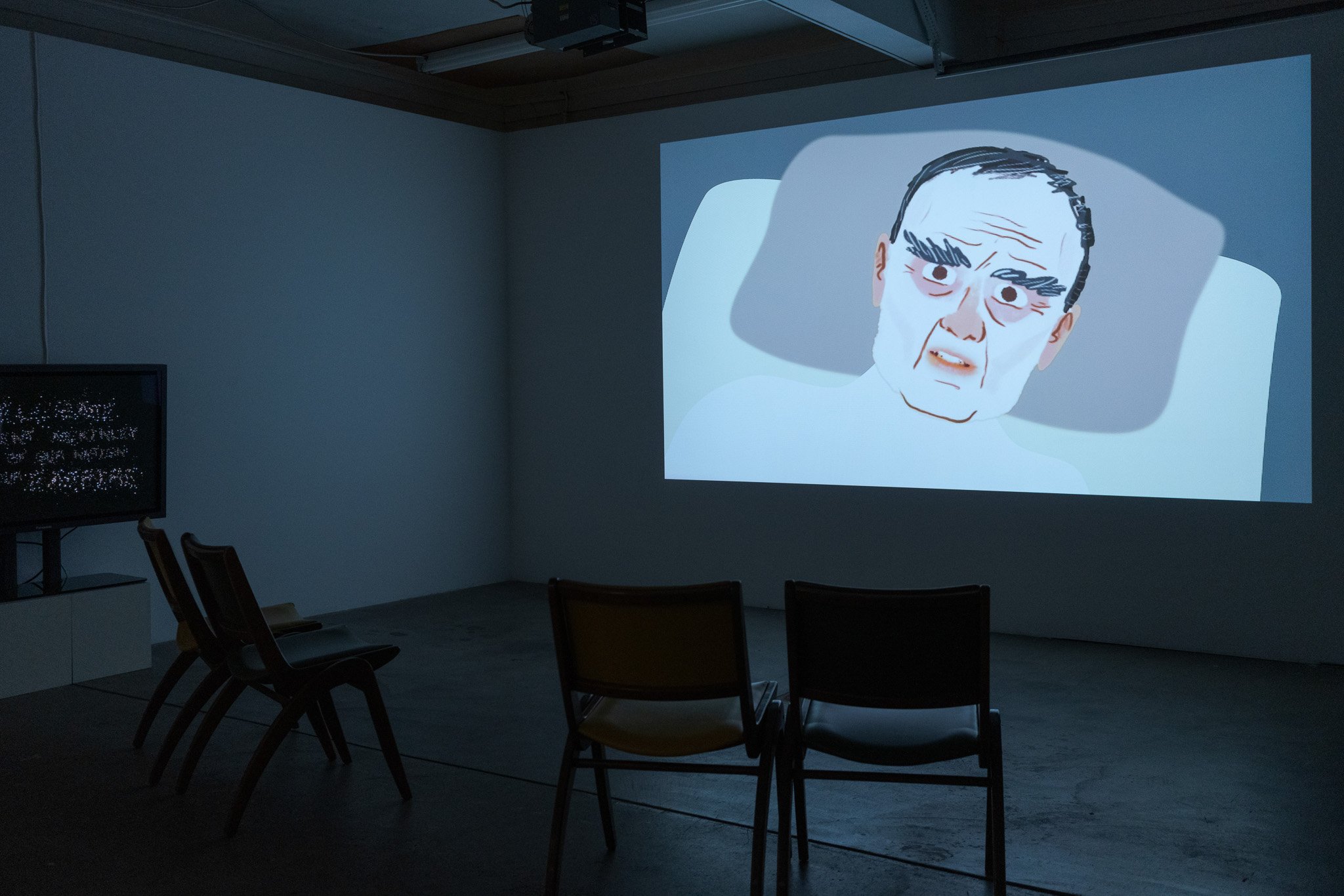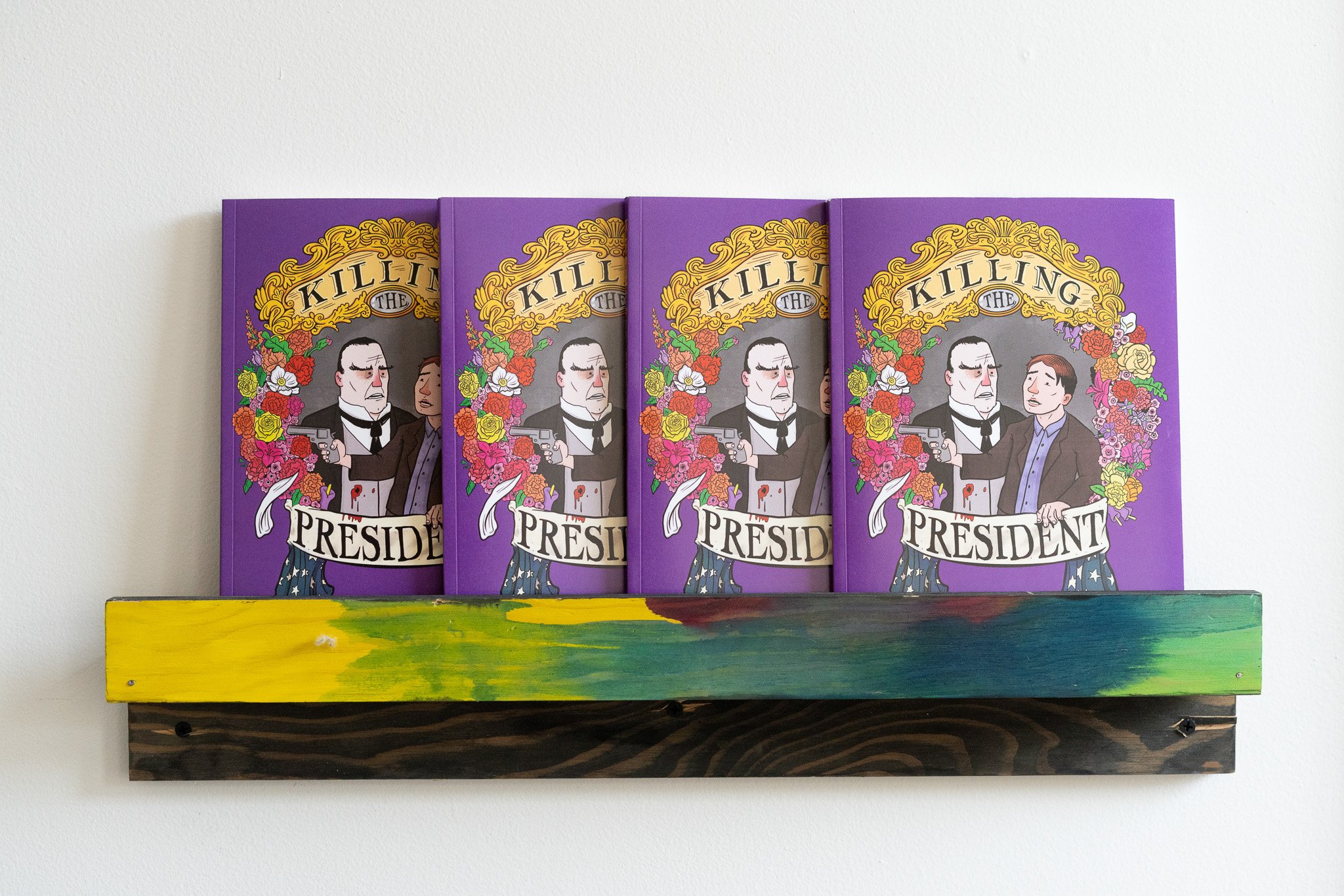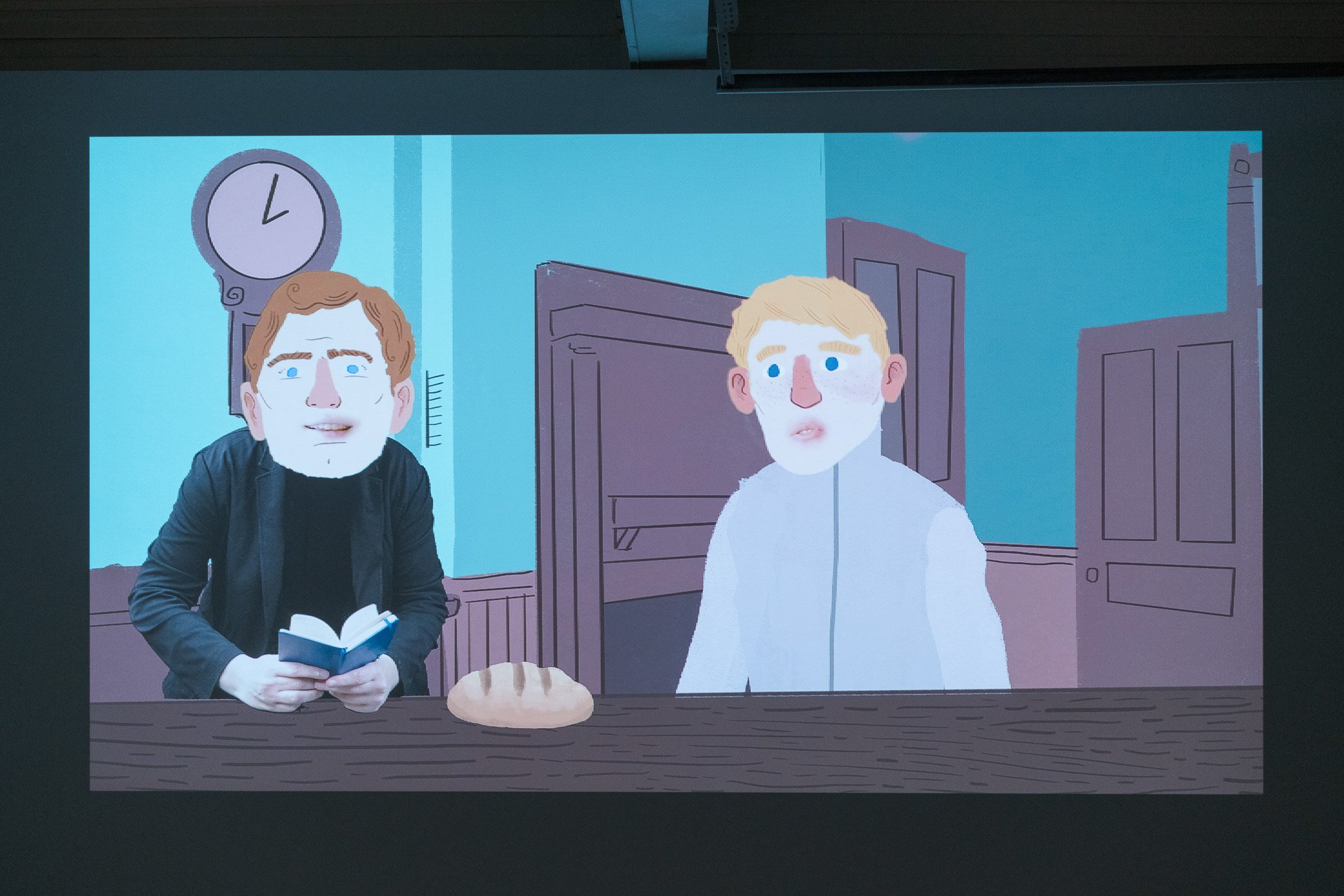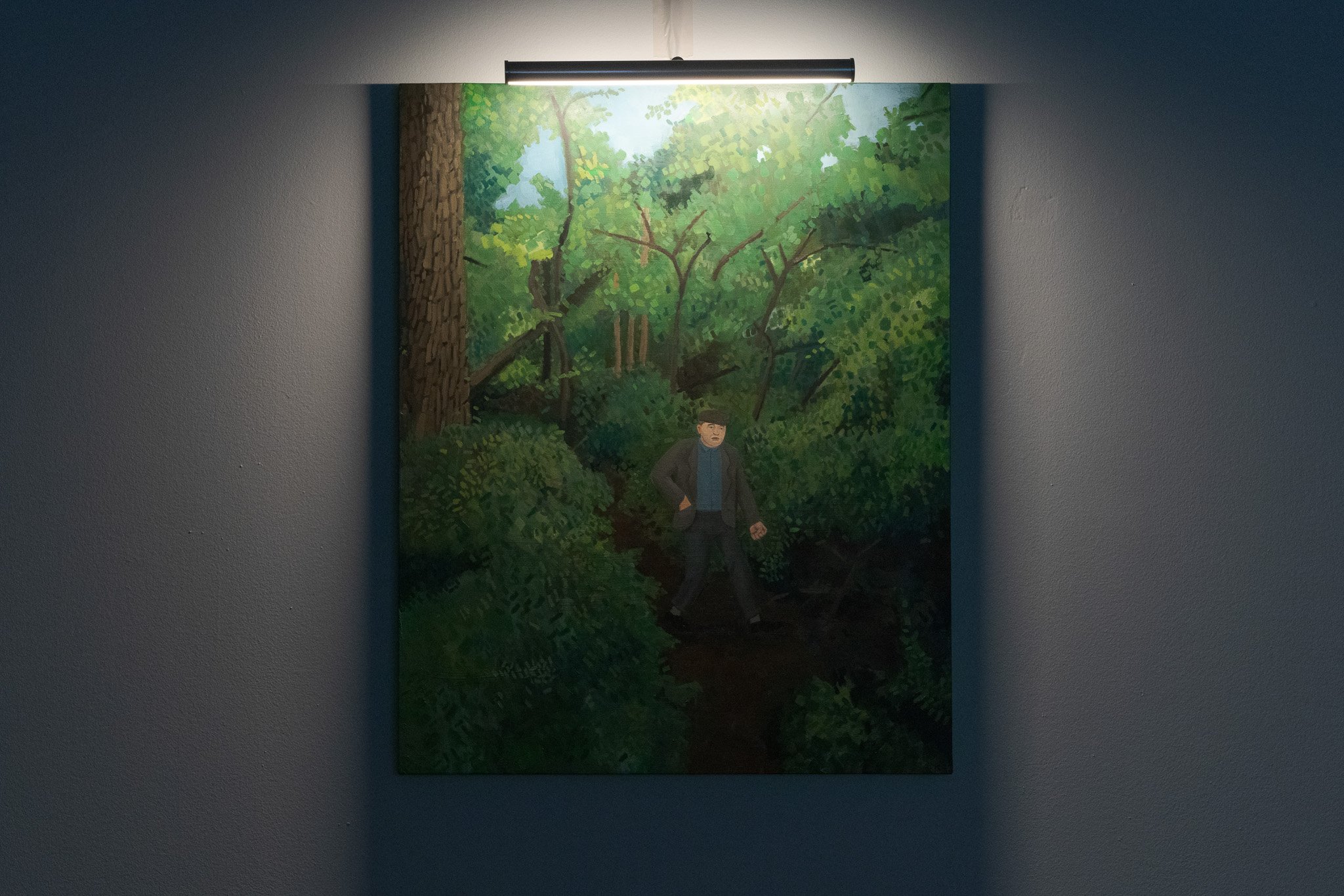Kate Rhoades: Propaganda of the Deed
Kate Rhoades, Propaganda of the Deed, 2020, installation view, The Buffalo Institute for Contemporary Art. Photo: Nando Alvarez-Perez.
October 9 - December 20, 2020
In Propaganda of the Deed, Kate Rhoades presents new experimental videos, paintings, and comics based on the assassination of President William McKinley by self-proclaimed anarchist Leon Czolgosz in 1901 Buffalo, New York. The project incorporates deeply researched historical recreation, slapstick comedy, and queer fantasy putting focus on an often overlooked, but sharply relevant part of American history. Rhoades anchors the show's narrative on feminist radical Emma Goldman, who Czolgosz said inspired his violence with her anarchist speeches and writings. Goldman was referred to as the "most dangerous woman in America" by J. Edgar Hoover, the first director of the Federal Bureau of Investigation. Rhoades portrays the assassination, the events leading up to it, and its aftermath as both farce and fable.
Exhibition Images
Full Video
Essay
by Emily Mangione
For a president who consistently ranks middle of the pack in scholarly surveys of United States leaders and fares somewhat worse off in public opinion polls, William McKinley — or at least his assassination by self-proclaimed anarchist Leon Czolgosz at the 1901 Pan-American Exposition — has an oddly oversized presence in Buffalo. There is what was for me — and I’m assuming many others raised in Western New York — the semi-obligatory field trip to the hagiographic Theodore Roosevelt Inaugural Site. For many years, I worked across Scajaquada Creek from The Buffalo History Museum, housed in the only remaining structure from the Pan-American Exposition; the Temple of Music, where McKinley was shot, would have been just a couple blocks north. And then there’s the unremarkable, blue-and-gold signpost just around the corner from my apartment: “Site of the Milburn House. Here died William McKinley, September 14, 1901.”
Courtesy of artist Kate Rhoades, I now have a very different vision of the eight-day fiasco neatly elided by the sign’s terse language, one complete with catchy rhymes (“If it’s closer to green, it might be the spleen. Stay away from red, or he’ll soon be dead.” “If the problem’s a bullet, you check in his gullet.”), reminiscences of those halcyon days of low-bar medical licensing (“Do you remember medical school? Yeah, my one year of medical school.” “The doctors from the fair said they were sure [the bullet] was in the spleeno-rectal zone.”), and “exploration cuts” taking the form of tic-tac-toe boards, leaking green ooze, and leaving the walls of the president’s sick room covered in escalating amounts of blood splatter.
These darkly comic scenes come courtesy of Rhoades’s Propaganda of the Deed, a digital video combining hand-drawn animation with filmed elements to share a decidedly askance history of the McKinley assassination. Assisting in this undertaking at the Buffalo Institute for Contemporary Art are a second video (Pan Am Pyrotechnics), a comic book (Killing the President), two paintings (Goldman gives a Speech and Czolgosz in the Woods), and a flag (Goldman Pince-nez Flag).[1] Taken together, what Rhoades offers us in Propaganda of the Deed as an exhibition is an experiment in producing counter-models of historical praxis, one that takes seriously the radical potential of humor as a tool. In so doing, Rhoades joins a celebrated constellation of artists who push against the limits of the archive imposed by the interests of power and those procedures by which the past is authenticated, ratified, and organized into purportedly objective “knowledge,” histories that fail to disclose the stories told otherwise that they occlude.
Returning to McKinley and the 1901 Pan-American Exposition, one of these commonly occluded stories irrupts into the present in Pan Am Pyrotechnics. Shown on a loop, the message “welcome President McKinley, chief of our nation and our empire” explodes into visibility and then becomes increasingly illegible as the sparklers tracing its letters burn out (a tidy metaphor, in its own way, for the vagaries of historical memory). The key term, by size alone, is “empire”: a designation the United States has persistently attempted to avoid, especially in periods like the McKinley administration when the nation was actively engaged in campaigns of occupation. In Killing the President, an illustrative primer on the rapacious territorial expansionism that characterized McKinley’s first term in office is likewise the only section called out in color. Rhoades’s recounting also emphasizes how McKinley’s preoccupation with serving as chief of an ever-expanding empire meant he was decidedly less concerned with his role as chief of the domestic homeland, ignoring pleas for redress of white supremacist violence that led to an 1898 coup and the deaths of three-hundred African Americans in Wilmington, North Carolina, and attacks elsewhere throughout his time in office. A conversation between Goldman and one of her fellow party-goers in Propaganda of the Deed underscores how the connection between the exploitation of workers at home, of soldiers conscripted into the Spanish–American and Philippine–American Wars, and the colonized citizens of Cuba, Puerto Rico, Guam, Hawai‘i, and the Philippines would have been a pressing concern to radical thinkers at the time — even as McKinley’s and Roosevelt’s aggressive imperialism has largely faded from conventional histories of their rule today.
Despite official coyness around an embrace of the United States as emerging empire, the Pan-American Exposition as a whole, as Rhoades reminds us in Killing the President, was “a celebration of imperialism, colonization, white supremacy, and genocide.” While such an understanding of the Exposition has largely fallen out of histories that center the narrative of this event around McKinley’s death, it is similarly in line with the perception of the Exposition by its critics at the time. Following Rhoades’s disruption of the normative casting of the Exposition as an innocuous background to tragedy might allow us to return to the fore the story of pioneering civil rights activist Mary B. Talbert. Talbert, alongside members of Buffalo’s Phyllis Wheatley Club — an activist and social aid organization for Black women she cofounded in 1899 — rallied against the all-white organizers of the Exposition for their decision not to include any recognition, never mind celebration, of contemporary African American life, originally limiting their representations of blackness to “African Village” and “Old Plantation” displays. Through their persistence, Talbert and her compatriots eventually convinced the organizing committee to include a showcase of African American intellectual and creative accomplishments in science, art, literature, agriculture, and education designed by Thomas J. Calloway and W. E. B. Du Bois within the four-acre Liberal Arts and Manufacturing Building.
And then there’s the story of radical feminist and anarchist Emma Goldman. After his arrest, Czolgosz claimed to have been inspired by Goldman’s speeches and writings, greatly exaggerating the scope of their contact perhaps out of misguided infatuation. Acquiescing to a popular mania for ever-more persons to punish for the assassination, authorities arrested Goldman and several other anarchists on suspicion of having been involved with the planning of the attack. After two weeks of detention and subjugation to what she called the “third degree,” Goldman was released on an utter dearth of evidence. Despite all this, Goldman refused to condemn unequivocally Czolgosz’s actions — a stance for which she was rewarded with widespread, violent opprobrium by the press and that alienated her from even those within her own movement, the majority of whom largely dismissed Czolgosz’s would-be propaganda of the deed as foolish and impractical.
Kate Rhoades, Czolgosz in the Woods, 2020. Oil on panel, 24 x 30 inches. Courtesy of the artist. Photo: Nando Alvarez-Perez.
The idea of “propaganda of the deed” that gives the exhibition its title is also fundamentally grounded in the issues of history and storytelling, albeit in the present tense: shaping narratives as they unravel live with a keen eye toward how these land in the hearts and minds of an imagined audience. Czolgosz’s and the concept’s births are near coincidental; the latter first develops traction in the France of 1870–71: a fleeting moment in which the rapid and complete collapse of the French state in the wake of the Franco-Prussian War seemed to open up a tantalizing window of opportunity for radically reimagining the relationship between the individual and power. The moment spurs anarchist firebrand Mikhail Bakunin to pen his “Letters to a Frenchman on the Present Crisis,” in which he exhorts, “from this very moment we must spread our principles, not with words but with deeds, for this is the most popular, the most potent, and the most irresistible form of propaganda.” Bakunin does not specify what kind of deeds he has in mind here, but it seems unlikely that he had in mind the violent and disruptive acts that would become synonymous with propaganda of the deed. In fact, in a prefiguration of historian and sociologist Max Weber’s 1919 argument that the monopoly over the legitimate use of violence is a defining characteristic of the state, Bakunin writes elsewhere in the text: “The anarchistic system of revolutionary deeds and action naturally and unfailingly evokes the emergence and flowering of freedom-and-equality, without any necessity whatever for institutionalized violence or authoritarianism. The authoritarian system necessarily leads to the triumph of naked reaction. The second will erect the Revolution on natural and unshakeable foundations.” Violent deeds make spectacular propaganda but are too tightly bound historically to the operations of the state to make productive anarchism. We find this sentiment echoed by the Goldman of Rhoades’s Killing the President, who defines anarchism to a rapt audience of supporters, including Czolgosz, as “the theory that all forms of government rest on violence and are therefore wrong and harmful as well as unnecessary.”
As Czolgosz’s bumpy upbringing and precarious openness to the economic privations of the country-wide downturn of the 1890s eventually led him into socialist and then anarchist circles, and as Europe was struck with a wave of anarchist-associated assassinations (Czar Alexander II of Russia in 1881, French president Sadi Carnot in 1894, King Umberto I of Italy in 1900 — an act of particular inspiration to Czolgosz, who carries a newspaper clipping describing the event as a motivational talisman in Killing the President) and bombings (Saint Petersburg’s Winter Palace in 1880, a prominent Barcelona opera house and the French National Assembly in 1893), drowned out are voices like that of anarchist and avowed pacifist Gustav Landauer, who advocated instead for deeds that would bring about new, more equitable forms of being with others beyond statist repression: “A renewed social form must be spurred on, through the transcendence of the present spiritual inertia, in pursuit of energetic action, designed to break barriers, and to prepare new ground for our seed. That is the propaganda of the deed, as I understand it. Everything else is passion, despair, or a great misconception. It hasn’t a thing to do with killing people; rather, it regards the rejuvenation of human spirit and will along with the productive energies unleashed by large communities.”
Kate Rhoades, Goldman gives a Speech, 2020 Oil on panel, 24 x 30 inches. Courtesy of the artist. Photo: Nando Alvarez-Perez.
In this evocation of a “renewed social form” and the “productive energies unleashed by large communities,” I find myself returning to Rhoades’s depictions of Goldman: at center of a canvas-filling field of bodies in Goldman gives a Speech and mingling with guests at an outdoor social gathering in Propaganda of the Deed. These are in notable contrast to how she imagines Czolgosz: in the pendant to Goldman gives a Speech, Czolgosz in the Woods, we find our would-be anarchist action hero surrounded not by comrades but a lushly painted forest; in Propaganda of the Deed’s pre-assassination vignettes set on his family’s farm, Czolgosz repeatedly and petulantly spurs all invitations to be in community with others (“You haven’t really left the house today. Do you want to come out with me and the boys? We were just going to walk around town, buy some refreshments, and hang out.” “You know, later tonight there’s going to be a dance at the community hall. . . . You should come out with us!”) and all requests to become a more engaged participant in the familial community in which he is already purportedly a member (“You’re just kind of sitting there, not doing a whole lot. . . . At least mop the floors or something so Katrin doesn’t have to do it.” “You think you might be up to coming and working in the fields for a bit? We’re short one hand, and we could really use your help.”). Clearly Czolgosz’s interest in “build[ing] solidarity and people power” and issues of labor equity are more theoretical than practical. His attempt at forging a connection with Emil Schilling, “the premier anarchist of northeast Ohio,” comes off as such a comically one-sided fishing expedition for “where all the secret plotting happens, and the violence, and the planning for the violence, and the murder and the fighting and the bombings” that Schilling is convinced he’s a not-particularly-adept government spy.
Triangulating these two imagined positions with Landauer’s sidelined, alternative vision for propaganda of the deed raises the question: What would it look like if we took seriously Goldman’s constructive and community-generating acts as exemplars of propaganda of the deed as a method as opposed to the singular violence of an individual like Czolgosz? Goldman would have been painfully, personally aware of the limitations of a propaganda of the deed that limited itself to violence. Nine years prior to the McKinley assassination, she and her partner Alexander Berkman planned a similar attack on Carnegie Steel Company executive Henry Clay Frick as retaliation for his handling of the Homestead Strike, which culminated in a twelve-hour gunfight that left nine members of the Amalgamated Association of Iron and Steel Workers union dead. Berkman’s attack — for which he served fourteen years in prison — not only failed to kill Frick but also failed to generate any popular support for their larger anarchist project. Despite being frequently described as a defense of Czolgosz, Goldman’s “The Tragedy of Buffalo” — quoted in the final scene of Propaganda of the Deed and reproduced in full in Killing the President — is not a defense of violence: “It is proven that Anarchism and violence are as far apart from each other as liberty and tyranny. . . . Anarchism, being, a philosophy of life, aims to establish a state of society in which man’s inner make-up and the conditions around him, can blend harmoniously.” Later, in her My Disillusionment in Russia, Goldman would go on to distance herself more thoroughly from the tactics of the Frick and McKinley actions, writing “there is no greater fallacy than the belief that aims and purposes are one thing, while methods and tactics are another. . . . The means employed become, through individual habit and social practice, part and parcel of the final purpose.” She concludes that “it is one thing to employ violence in combat, as a means of defense. It is quite another thing to make a principle of terrorism, to institutionalize it, to assign it the most vital place in the social struggle. Such terrorism begets counter-revolution and in turn itself becomes counter-revolutionary.” Violent deeds might have some use in addressing the concerns of the moment, but their revolutionary efficacy is sapped by an inability to project positively toward a shared future.
Maybe this is what it would mean to fly the Goldman Pince-nez Flag: to take up Rhoades’s revelatory provocation to recognize the standard processes and practices of history and its privileged narratives as nothing natural but a choice of pressing consequence for the present. Under her aegis, we might yet reimagine what a “propaganda of the deed” of use for the social community and the practice of freedom might entail.
[1] All works except Goldman Pince-nez Flag (2019) are 2020.
ABOUT THE ARTIST:
Kate Rhoades lives and works in Oakland, California. Her videos, paintings, and publications employ humor to probe systems of power. She has presented works in the San Francisco International Film Festival and the Santa Fe International New Media Festival. Rhoades has participated in exhibitions at Trestle Gallery in Brooklyn, Southern Exposure in San Francisco, and various venues, publications, hotel rooms, and alley ways across the globe. Since 2014 she has co-hosted the Bay Area's number one arts and culture podcast, Congratulations Pine Tree. Rhoades was also one of the Fleishhacker Foundation's Eureka Fellowship grantees in 2018.
SUPPORTED BY:
The series Humor as a Tool is funded in part by the New York State Council on the Arts with the support of Governor Andrew Cuomo and the New York State Legislature; administered by Arts Services Initiative of Western New York.











